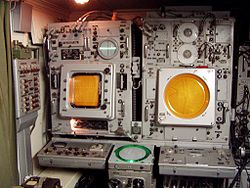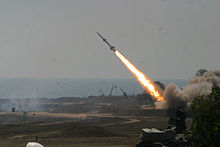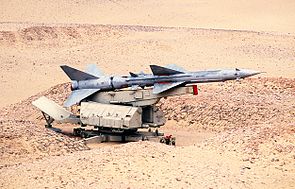S-75
| S-75 | |
|---|---|
| General Information | |
| Type | Surface-to-air guided missile system |
| Local name | S-75 Dwina |
| NATO designation | SA-2 guideline |
| Country of origin |
|
| Manufacturer | OKB-2 Lavochkin |
| development | 1953 |
| Commissioning | 1957 |
| Working time | In service |
| Technical specifications | |
| length | 10.78 m |
| diameter | Booster: 456 mm Rocket: 500 mm |
| Combat weight | 2391 kg |
| span | Booster: 2566 mm Rocket: 1691 mm |
| Drive First stage Second stage |
Solid fuel booster , liquid fuel rocket engine |
| speed | 885 m / s |
| Range | 7-43 km |
| Service ceiling | 1000-30,000 m |
| Furnishing | |
| steering | Inertial navigation platform |
| Target location | Radar target tracking with radio command steering |
| Warhead | 190 kg fragmentation warhead |
| Detonator | Proximity and impact fuses |
| Weapon platforms | Semi-stationary position |
| Lists on the subject | |

The S-75 Dwina ( NATO code name : SA-2 Guideline ) is an anti-aircraft missile complex that was developed in the Soviet Union in the 1950s . It is still in use today and is one of the most widely used and widely used air defense systems.
history
The anti-aircraft missile system was named after the Russian rivers Dvina , Desna and Volkhov ( Russian С-75 Двина , Десна and Волхов ). The development of the system started in November 1953 by the Almaz design office under Boris Bunkin , the rocket itself was developed by the development office in Fakel under the direction of Pyotr Gruschin . The weapon should be able to intercept high-flying British and American bombers such as the B-52 . Test flights were carried out from 1955. The system was classified as operational in 1957 and put into service from 1959. The S-75 was developed as a cheaper missile that could be stationed in many regions instead of the expensive S-25 .
The complete system of missiles, radar and other devices can be transported on vehicles and trailers. The typical battery consisted of six starters, an RSNA75 radar, and several mobile generators . Due to the limited detection range of the RSNA75 radar, target data was initially recorded by more powerful devices such as the P-12 radar and passed on to the S-75 battery via a wire connection.
In 1958 the first five batteries with 62 missiles were delivered to the People's Republic of China . At the height of the S-75 proliferation in 1969, the Soviet Union had installed over 800 missile batteries on its territory.
From 1961 the modernized version S-75M was introduced and put into service from 1962. Above all, the radar system has been improved, as it can now better deal with countermeasures such as chaff and jammers.
functionality
The S-75 system consists of two-stage radar-guided missiles of the type W-75, the early warning radar P-12 Jenissei (NATO code name: Spoon Rest) with a range of up to 275 km and the fire control radar RSNA-75 (NATO code name: Fan Song), range 60–145 km.
A ground station picks up the target using radar and directs the rocket using radio commands . The ground station consists of the units UW (to control the missile), RW (to power supply), PW (antenna system for signal transmission to the missile), AW (contains most of the electronic components of the system) and ZÄF (to differentiate between friend and enemy aircraft on the radar). A fire control officer , the shooter (as commander), two draftsmen and three radio locators work in the UW .
The control system can only capture one target at a time and fight with up to three missiles. In order to counter evasive maneuvers by the pilot, an interval of six seconds is usually chosen between the starts. Only after the end of the flight time can new missiles be launched or a new target acquired.
Typically a position consists of six rocket launchers, each with one rocket, which are arranged in a hexagon at a distance of about 100 m. In the middle are the radar and control systems as well as six other missiles for reloading. Use against sea or land targets is also possible under certain conditions. Depending on the speed of the approaching target and the resulting "encounter time", the fragmentation zone of the warhead can be varied towards the front, side or rear. The ignition is carried out by a radio-electronic proximity detonator, which has received a preset number of reflected pulses. The destruction of the target itself is caused by the high energy flying parts of the fragmentation casing of the warhead.
The outdated radar systems are now easily disrupted by ECM . There are modernized variants with a long-range optical sight (camera) and spatially reduced radar scanning (pulse bundle regime). In the event of an air attack with ARM anti-radar missiles on an S-75 complex, the radar can be switched off if it is located in good time. Due to the increasing angle error of the approaching ARM, their probability of being hit is reduced. It is also possible to simulate virtual SA targets for the ARM with remote simple transmitters. In the meantime, the S-75 missiles that are already in the air can be taken over by radio from neighboring S-75 control stations and can still be guided into the target. Due to the exclusive equipment with tube technology, the older, not modernized missile complex is only briefly disturbed by an EMP of a nuclear explosion and is then ready for use again.
Technical specifications
| S-75M Dwina | |
|---|---|
| Type | Remote-guided anti-aircraft missile |
| power | |
| speed | Mach 3 (1030 m / s) |
| Combat range (max.) | 29 km |
| Combat range (min.) | 5 km |
| Control level (max.) | 27 km |
| Control level (min.) | 500 m |
| Extermination zone | 5-35 km |
| drive | PRD18- solid booster / S2711W- liquid rocket (main stage) |
| thrust | 27–50 t for 5 seconds / 3.1 t for 25 seconds |
| Weight | |
| Total mass | 2287 kg |
| Warhead | 190 kg HTA explosives |
| Dimensions | |
| length | 10.72 m |
| Diameter (rocket, max.) | 0.5 m |
Calls
The first successful use took place in 1959. In 1958, the Soviet Union delivered five S-75 batteries with a total of 62 missiles to the People's Republic of China, which was in conflict with the Republic of China . The Republic of China Air Force continued US RB-57D - spy planes to raise awareness of the People's Republic, where one was hit 20 km altitude of three S-75 rockets on 7 October 1959th However, the circumstances of the shooting down have been obscured and the shooting down has been officially attributed to Chinese fighters in order to hide the existence of the S-75 in China.
Internationally, the S-75 system only became known when a US spy plane U-2 was shot down on May 1, 1960 over the Soviet Union. Francis Gary Powers' machine was shot down south of Sverdlovsk , the pilot survived and was captured. A total of 14 anti-aircraft missiles were fired, in addition, MiG-19 and Su-9 fighter planes were attached to the U-2. Due to faulty communication with the fighter control center, one of the missiles hit a MiG-19, the pilot of which was killed. Up until that day, the Americans had assumed that the operating altitude of the U-2 was beyond the range of all air defense weapons.
On September 5, 1961, American U-2 reconnaissance planes discovered Soviet S-75 positions during spy flights over Cuba . During the Cuban Missile Crisis on October 27, 1962, another U-2 was shot down with an S-75. The pilot, Major Rudolf Anderson , was killed.
During the Vietnam War , North Vietnam also used the S-75 anti-aircraft missile. As early as 1965 shortly after the start of the US air offensive Operation Rolling Thunder, the first systems were installed. Although US scouts were able to locate and identify the installations, they were not attacked until the first casualties were recorded (first shot down in July 1965). The S-75 was a central part of the integrated North Vietnamese air defense for combating high-flying targets. Even John McCain , later US presidential candidate, was shot in October 1967 by a S-75 miles. In 1972 65 S-75 positions were distributed in North Vietnam. During the US Operation Linebacker II in December 1972, in which the US carried out around 740 attacks with B-52 bombers and around 1200 attacks with other fighter aircraft on the cities of Haiphong and Hanoi in eleven days , the North Vietnamese air defense was able to manage 15 B-52s - Shoot down bombers and 10 other fighter planes with S-75.
During the Yom Kippur War in October 1973, the S-75 was an important protection of the Egyptian offensive against attacks by Israeli mirage and phantom warplanes.
variants
HQ-1/2/3/4
The versions HQ-1/2/3/4 are Chinese license builds of the S-75.
DF-7
The Dongfeng DF-7 (also M-7 , Project 8610 or CSS-8 ) is a short-range ballistic missile of the People's Republic of China. The range is 180 km, its warhead weighs between 190 and 250 kg. It can be armed conventionally, chemically or with cluster munitions . The DF-7 was developed on the basis of the HQ-2 , decommissioned HQ-2s were converted to DF-7.
Prithvi
The Indian short-range rocket Prithvi ("Earth") has been using the liquid propulsion unit of the S-75 since 1987. There are three variants with a range of up to 350 km, and it served as the upper stage of the first Indian satellite carrier 1992-1994.
User states



The S-75 complex was widespread in the former Warsaw Pact states and some of it can still be found there today, although it is technically out of date. In the NVA of the GDR , there were about 25 S-75 systems. Also in the Air Force of North Korea , many, probably modernized are still complexes in service.
Current users
-
 Azerbaijan - 25
Azerbaijan - 25 -
 Egypt - 240, Tayer el-Sabah variant
Egypt - 240, Tayer el-Sabah variant -
 Bulgaria - 18
Bulgaria - 18 -
 People's Republic of China - HQ-1/2/3/4
People's Republic of China - HQ-1/2/3/4 -
 Iran - more than 300 launchers, including HQ-2J and Sayyad-1 A missiles are used
Iran - more than 300 launchers, including HQ-2J and Sayyad-1 A missiles are used -
 Yemen
Yemen
-
 Kyrgyzstan
Kyrgyzstan
-
 Cuba
Cuba
-
 Libya
Libya
-
 Mongolia
Mongolia
-
 Myanmar
Myanmar
-
 North Korea - approx. 270
North Korea - approx. 270 -
 Pakistan - Chinese HQ-2B missiles in service with the Pakistani Air Force
Pakistan - Chinese HQ-2B missiles in service with the Pakistani Air Force -
 Romania
Romania
-
 Zimbabwe
Zimbabwe
-
 Sudan - 700
Sudan - 700 -
 Syria - 275
Syria - 275 -
 Tajikistan
Tajikistan
-
 Turkmenistan
Turkmenistan
-
 Vietnam - 280
Vietnam - 280
Former users
-
 Afghanistan
Afghanistan
-
 Albania - 84 starters
Albania - 84 starters -
 Algeria
Algeria
-
 German Democratic Republic
German Democratic Republic
-
 Georgia
Georgia
-
 Indonesia
Indonesia
-
 India
India
-
 Yugoslavia - now retired in the successor states
Yugoslavia - now retired in the successor states -
 Iraq
Iraq
-
 Poland
Poland
-
 Russia - Retired between 1991 and 1996. More modern systems are used. Remaining S-75 missiles are z. T. as target drones used
Russia - Retired between 1991 and 1996. More modern systems are used. Remaining S-75 missiles are z. T. as target drones used -
 Somalia - status unclear
Somalia - status unclear -
 Czechoslovakia - 23
Czechoslovakia - 23 -
 Hungary
Hungary
See also
Web links
- Przeciwlotniczy system rakietowy S-75. Accessed August 14, 2014 (Polish, variants and technical data).
- Page about the S-75 / SA-2
- http://www.raspletin.ru/produce/adms/s75/ ( Memento from August 17, 2010 in the Internet Archive ) Manufacturer's website (Russian)
Individual evidence
- ↑ a b c d e f Steven Zaloga: Red SAM: The SA-2 Guidline Anti-Aircraft missile. Osprey Publishing, 2007, ISBN 978-1-84603-062-8 .
- ^ Carlo Kopp: Engagement and Fire Control Radars. August 2011, accessed August 14, 2014 .
- ↑ Jack Broughton: Thud Ridge . F-105 Thunderchief missions over Vietnam. Crecy Publishing, 2006, ISBN 978-0-85979-116-8 , pp. 276 (English, limited preview in Google Book Search [accessed December 24, 2015]).
- ↑ DF-7 / M-7/8610 / CSS-8. In: globalsecurity.org. Retrieved February 2, 2015 .
- ↑ M-7 (CSS-8 / Project 8610). (No longer available online.) In: missilethreat.com. Missile Threat, archived from the original on February 11, 2015 ; accessed on February 2, 2015 .



